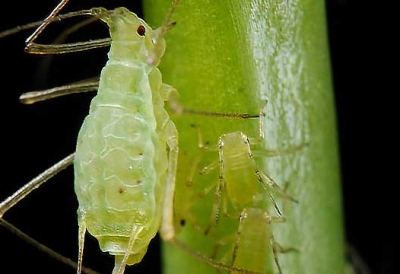Name the plant and there’s probably an aphid species that enjoys munching or hanging out on it. With more than 350 types of the insect, it’s almost a sure bet that at least one species of aphid will spend time in your garden.
Not all aphids are problematic. Most species have natural predators and the circle of life plays out in the gardener’s favor. But even if the insects aren’t chewing through blooms, petals or leaves, the sticky honeydew they excrete can be an annoyance.
The best known aphid eater is the ladybug (also known as the lady beetle). Although both native and Asian lady beetles (and their larvae) have a voracious appetite for aphids, always check with a state or county agency before purchasing insects as a control method. Asian beetles are 
The larvae of green lacewings and flower flies are also fond of aphids. There are several species of tiny wasps that use aphid bodies as egg incubators, laying their eggs inside the body. After hatching, the wasp larvae eat the aphid from the inside out.
Many aphid infestations can be controlled with a strong daily spray of water, which either kills the pests or knocks them to the ground. A good fall cleanup can also ensure overwintering eggs laid on perennial stems don’t make it to the following spring. Cut back stems and discard or burn away from established plantings.
If an aphid infestation is out of control, chemical treatment may be required. Horticulture oils work by smothering aphids. Insecticides can be applied to either the soil or plant leaves, depending on time of year.
For more information about aphid control, contact SprayTech, Colorado commercial and residential insect control specialists, at 720-248-0000.
Comments are closed.